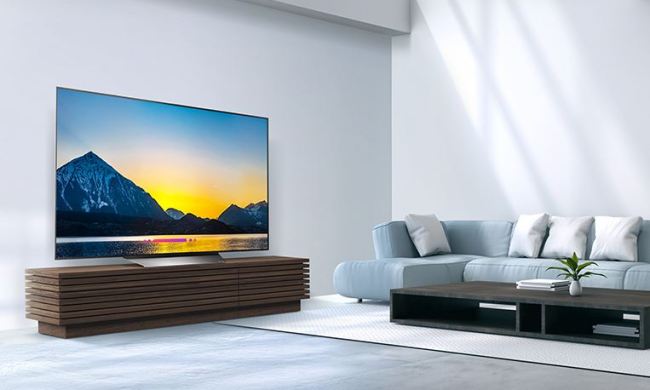
“The Nothing Ear Stick earbuds and case look incredible, with a design that's unlike any other, but the just-acceptable sound quality and simple feature list mean they don't live up to expectations.”
- Eye-catching design
- Long battery life
- IP54 rating
- Big buds may cause fit problems
- No voice assistant support
I guarantee you’ll smile when you twist the Nothing Ear Stick earbuds case open. It’s just so satisfying, so cool-looking, and so fun that it’s impossible not to. It’s a great introduction to one of the most impressively designed and lovingly created set of true wireless earbuds I’ve used since the McLaren Klipsch T5 II Sport. So they have exactly the right style, but do the Nothing Ear Stick’s have the right sound to back the looks up?
Nothing Ear Stick design

Nothing has proven it knows how to design an eye-catching product with the Ear 1 earbuds and the Phone 1 smartphone. The Ear Stick earbuds, silly name aside, continue that tradition, in particular with the case. Supposedly influenced by the shape of a lipstick, it’s a wonderfully ergonomic, tactile work of art. The earbuds are visible through the transparent body, and with a twist, the case opens to allow you to take the earbuds out. Magnets dampen the motion and lock the case in its open or closed position.
The Ear Sticks’ stems are made of the same transparent plastic as the Ear 1’s stems, but this time they’re attached to semi-open — or “half in-ear” as Nothing likes to say — earbuds, which apparently are the result of 100 design revisions. Due to this, I expected the Ear Sticks to be as comfortable and easy to wear as the Nothing Ear 1 earbuds. But for me, they can’t quite match them. The problem isn’t discomfort — it has to do with size. The Ear Sticks’ speaker housings are much bigger than Apple’s first-generation AirPods, and have a bulbous, ultrasmooth lozenge-shape that refuses to lock into my ears.
All ears are different, so while I find the Ear Sticks easily work themselves to the edge of my ears, they may fit better in yours. If I’m sitting still, they’re fine, but as soon as I’m moving around and doing things, they start to work themselves loose. Only one has accidentally fallen out so far, but it’s perhaps because I’m very conscious about them and often reposition the bud so it sits deeper in my ear. I have never had this problem with AirPods, which feel a lot more secure. At 4.4 grams, they aren’t heavy either. It’s just the size and shape of the speaker housing that’s the problem for me.

The size of the Ear Stick earbud is the only real downside to the design, and it will go on to impact sound quality, which we’ll come back to soon. Otherwise, the whole package looks modern and stylish, and certainly won’t be mistaken for any other brand’s earbuds. This is worth noting in itself, as Nothing absolutely hasn’t tried to copy the AirPods, and continues to build its own distinctive brand identity through clever designs that really do make you smile when you try them out.
On the durability side, the plastic case should be hardwearing, and the earbuds have an IP54 water- and dust-resistance rating, so you’ll be fine wearing them to exercise or in a dusty work environment.
Nothing Ear Stick call sound quality
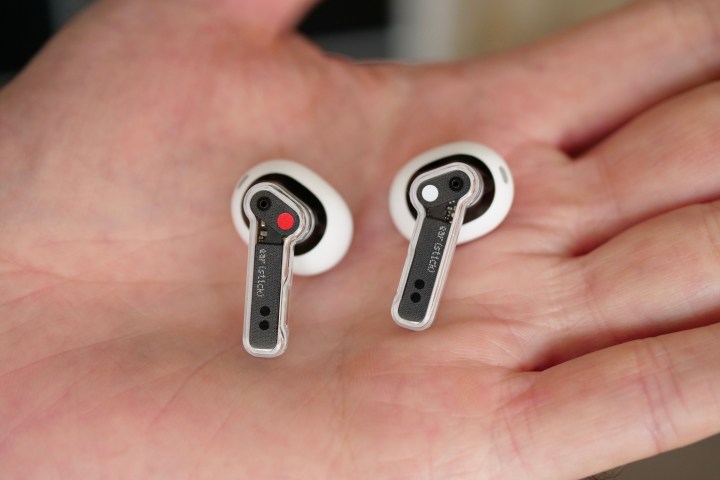
Inside the large enclosure is a 12.6mm driver, with a Bass Lock feature where software compensates for bass loss through the open design and tunes the equalizer accordingly. Frustratingly, Nothing has not included AptX codec support, and the Ear Sticks only support AAC and SBC codecs, same as the Ear 1. There are three microphones and a custom algorithm to remove wind and crowd noise during calls.
They may be the coolest-looking ‘buds you’ll ever see, but not the best you’ll ever hear.
Let’s start with calls. I’ve used the Ear Sticks with Teams video calls, WhatsApp video and audio calls, and regular phone calls both inside and outside the house. For me as the caller, the quality is excellent, with clear voices and no obvious background noise intruding on the conversation. It’s more of a mixed bag for the person on the other end though. During Teams calls, it apparently sounded very similar to my usual choice of headphone — the Samsung Galaxy Buds Live — but it wasn’t so good elsewhere.
WhatsApp calls apparently made me sound like I was in an echoey box, but the app itself may not have helped here, as this was not quite so apparent during regular calls. Wind and traffic noise was minimal until it wasn’t, as the Ear Sticks would suddenly pick up either a gust of wind or a vehicle passing by and amplify it on the call. In the house, none of these issues occurred, and the call was fine for both parties.
Nothing Ear Stick music sound quality
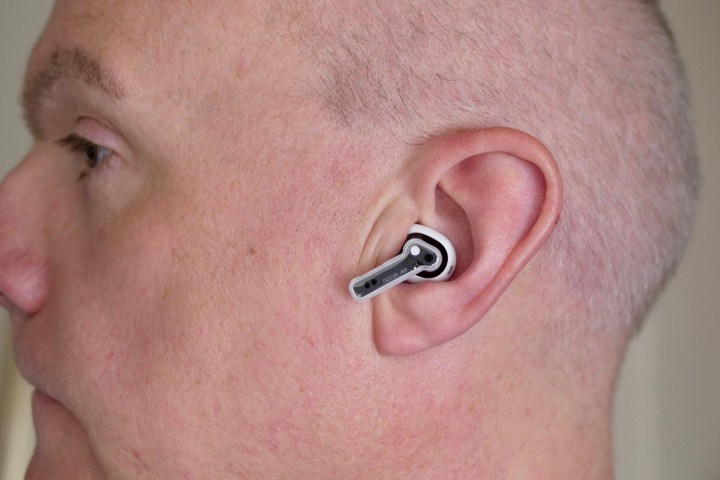
The Ear Sticks don’t have silicone eartips and therefore do not isolate you from the outside world. The barely there design means you can hear everything around you when music isn’t playing, and still have some idea of what’s going on around you when it is. The Ear Sticks are ideal if you’re concerned about safety when out and about, just like Apple’s AirPods.
However, despite not being tightly sealed in your ears, the Ear Sticks still pack a decent punch. I’ve watched films and listened to both spoken word and music, and not felt the need to swap to a different pair of headphones. However, when taken out of isolation and compared with other similar headphones — I used a pair of first-generation Apple AirPods, the Galaxy Buds Live, and Huawei’s FreeBuds 3 — the Ear Stick’s weaknesses show up.
Le Serrafim’s Fearless mini-album is a serious test, combining strong female vocals that should be the focus of the soundstage with a hard-hitting bassline and sparkling mids and percussion. There is plenty of volume and the bass is defined listening with the Ear Sticks, but they lack the punch of Apple’s AirPods. The vocals are rather harsh and bright, where Apple’s earbuds remain clear and controlled at the same volume. Putting them against the Huawei FreeBuds 3 also revealed how the Ear Sticks enhance the treble, to the point where clarity and listening comfort can be compromised at high volumes.
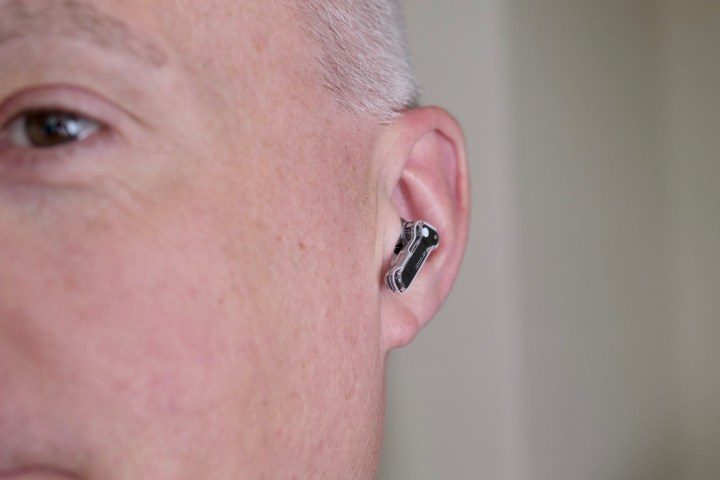
The Ear Sticks definitely aren’t what you’d call refined, and despite the promise of the Bass Lock feature, both the AirPods and the FreeBuds 3 have a tighter bass response. The Ear Sticks aren’t unpleasant to listen to, but considering how good the Ear 1’s sound — I use them on a regular basis and still love them — I had high expectations, and the lack of polish makes the Sticks sound cheaper than they actually are.
Now we come back to the problem of the Ear Stick earbuds not sticking in my ears very well. Sitting down and listening isn’t an issue, but the sound is negatively affected when they wobble themselves lose as I move around. This may not affect you in the same way, but it’s not something I’ve noticed as much with any other pair of semi-open earbuds.
Nothing Ear Stick connectivity and app

At the time of writing, Nothing has not released a dedicated app for the Ear Sticks, and the Ear 1’s app does not support the Ear Stick earbuds. They require the new, and as yet unreleased, Nothing X app. For this reason, I have not been able to check for a firmware update, which may improve the call quality and refine the sound. I have also not been able to try out the equalizer or customize the earbud’s controls.
I’ve used the Ear Sticks with an iPhone 14 Pro, an iPad Pro, a Mac Mini M1, and both a Google Pixel 7 and Pixel 7 Pro. They have connected to each device without a problem, and stability has been faultless. The Bluetooth range stretched to around 8 meters from my iPhone, but couldn’t match the range I get from my AirPods Pro or Sony WH-1000XM4 headphones, which reaches several meters further in my house.
Each earbud has a touch-sensitive panel in the stem to control playback and volume. It’s easy to locate when the earbuds are in, and there is a distinct “click” when you press it, helping confirm your action. By default, a short press plays or pauses the music, a long press adjusts the volume — left for volume down and right for volume up — and a double tap advances tracks. The control system works really well, but it doesn’t completely eliminate accidental presses, and I often pause playback when I’m fiddling with the Ear Stick to make sure it’s seated properly.
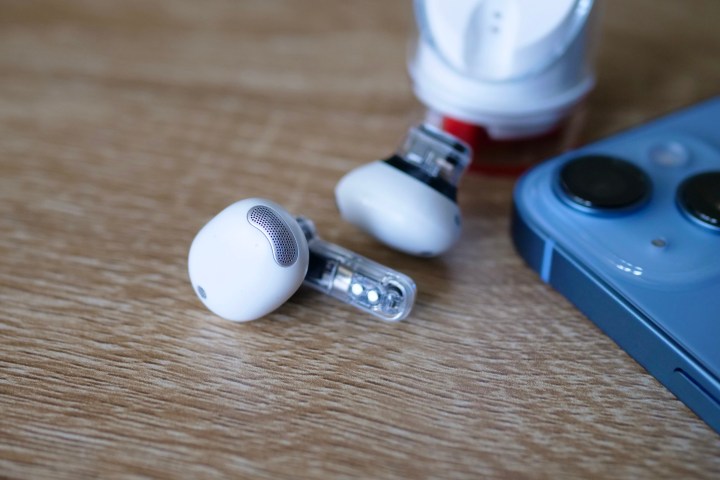
Don’t go looking for virtual assistant support, as none are available. This is an odd omission as it’s seemingly standard across all earbuds regardless of price. However, it’s not unexpected as the feature was also missing from the Ear 1 earbuds, but did arrive in a software update later on. Sensors detect when the earbuds are in your ears, and they pause effectively when you take them out. Fast Pair with my Pixel 7 and 7 Pro worked really well too, with the phones immediately picking the Ear Sticks up when I opened the case.
Nothing Ear Stick battery life and charging

There’s no active noise cancellation (ANC) on the Ear Stick earbuds to suck battery power, and Nothing claims a single charge will return about 7 hours of listening time or 3 hours of talk time. The case’s battery provides a total of up to 29 hours of listening time and 12 hours of talk time. I’ve been using the Ear Stick earbuds for under a week, so I can’t comment on long-term battery use yet.
On a single day using the Ear Stick earbuds connected to an iPad Pro to watch YouTube, Amazon Prime, and Dailymotion, the ‘buds were down to 10% charge after five-and-a-half hours, making about six hours likely for total use. This is comparable to the use time we got from the Apple AirPods 3. You charge the Ear Stick earbuds in the case using a USB Type-C connection, and there’s a cable included in the box, but no wireless charging. A 10-minute fast charge feature gives you two hours of use.
Nothing Ear Stick price and availability
The Nothing Ear Stick earbuds are available through Nothing’s online store for $99, or 99 British pounds. This is much cheaper than Apple’s AirPods 3, but still more expensive than many of the semi-open headphones out there, including the Oppo Enco Air, the Urbanears Boo, and the Huawei FreeBuds 4. You’re paying extra for the flashy design here. I regularly use the Samsung Galaxy Buds Live for calls and music, and appreciate the great sound quality and clever ANC feature to minimize external sound without cutting me off completely. I prefer them over the Ear Sticks.
Coincidentally and worth noting here is Nothing has decided to increase the price of the Ear 1 earbuds from $99 to $150, which it says is to do with rising costs, but it’s hard not to think it’s also to do with the Ear Sticks now occupying that price. The Ear 1 represented fantastic value at $99, but I don’t think the Ear Stick earbuds do the same. If you managed to get the Ear 1 headphones before the price increase, you got a great deal.
I appreciate that the Ear Stick’s aren’t going to always appeal to the same people the Ear 1 do, mostly because of the semi-open design, but I also can’t recommend the Sticks in the same way I did with the Ear 1. They just don’t represent the same level of value as the Ear 1 did at this price. That said, there are factors affecting prices today that may not have done so when the Ear 1 were released.
Nothing Ear Stick’s have the right style, but not the right price
Are the Nothing Ear Sticks all style and no substance? There’s definitely an emphasis on design and it does seem to bump up the price too, given the lack of ANC, AptX codecs, wireless charging, and virtual assistant support. Almost all of these come with the Ear 1 headphones, which launched at the same price. The case and earbud design is very cool, and I don’t think I’ll ever tire of opening and closing the case, but it’s not really a reason to buy.
Performance is decent but not class-leading, and the battery life doesn’t surpass the competition either, despite being perfectly acceptable. Problems with the fit definitely didn’t help me warm to the Ear Sticks, and it’s not like I have abnormally tiny ears, so I doubt I’ll be the only one who worries about one falling out and disappearing down a drain, never to be seen again.
All this brings me back to the price. When I tested the Ear 1, I often couldn’t believe the great features provided for $99, and how good they sounded. At no point have I had the same reaction with the Ear Sticks. They may be the coolest-looking ‘buds you’ll ever see, but not the best you’ll ever hear.


